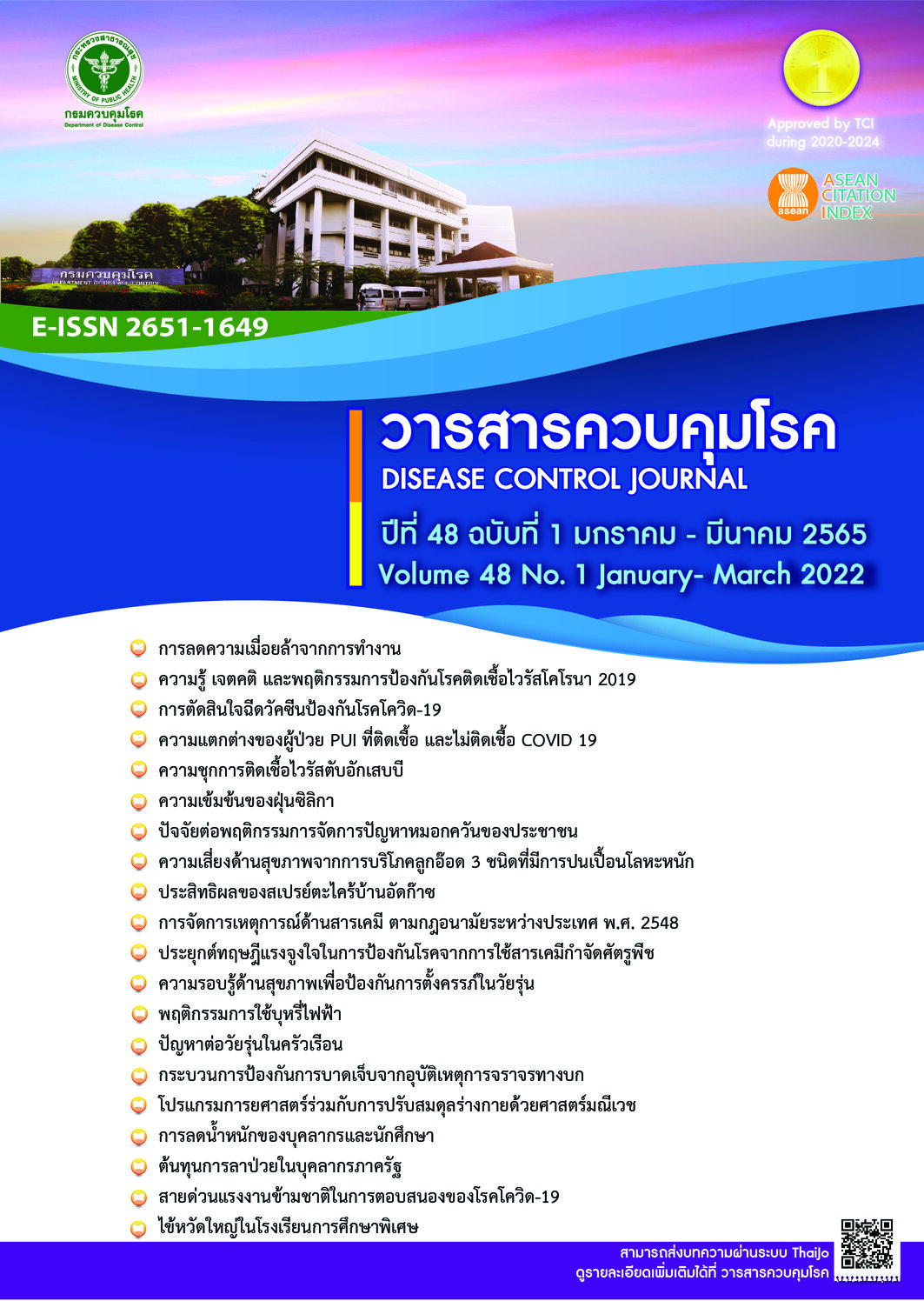Predicting factors of e-cigarettes use behavior among higher education students in Phitsanulok province
DOI:
https://doi.org/10.14456/dcj.2022.13Keywords:
Predicting factors, electronic–cigarettes, higher education studentsAbstract
E–cigarettes are toxic and damage to health but popular among teenagers. This predictive correlation research aimed to study predicting factor of e–cigarette use behavior among higher education students in Phitsanulok Province. The sample consisted of 380 male and female students studying at a bachelor's degree, aged 18 years old and above which selected by a multi–stage random sampling. The research instrument was questionnaire regarding perception, attitudes and behavior towards e-cigarette use with reliabilities at 0.78, 0.81, and 0.77, respectively. The predicting factors were analyzed by stepwise multiple regression analysis. The results showed that e-cigarettes use behaviors were at low level of 35.0%. The factors of e-cigarettes use behaviors at the level of 95% statistical significance were described as e-cigarette use of people around them (β=0.372), experience of receiving information about e-cigarettes selling via the Internet (β=0.261), perception about the dangers of e-cigarettes (β=0.173), and attitude toward prevent using e -cigarettes (β=0.125) which could predict at 47.3 percent (R2=0.473). The findings suggested that university executives and related staffs should develop strategies to control and prevent e-cigarette use among higher education students by promoting correct perception, and attitude towards e-cigarette use to contribute the correct behavior, which can be conducted by providing health education training as well as organizing club activities to prevent students from initiate smoking in the campus.
Downloads
References
Tobacco Control Research and Knowledge Management Center. Report on the situation of tobacco consumption in Thailand 2019. Bangkok: Tobacco Control Research and Knowledge Management Center, Mahidol University; 2019. (in Thai)
World Health Organization. report on the global tobacco epidemic 2019, offer help to quit tobacco use. Geneva: World Health Organization; 2019.
Phitayarungsathit S, Aiamanan P, Punkajung P, Sommit K. Summary of Tobacco Control in Thailand 2012. Bangkok: Tobacco Control Research and Knowledge Management Center, Mahidol University; 2012. (in Thai)
Lawrence A, McKenna JR. Electronic Cigarette Fires and Explosions in the United States 2009–2016. US: U.S. Fire Administration; 2017.
United States Department of Health and Human Services. E-Cigarette Use Among Youth and Young Adults, A Report of the Surgeon General. USA: National Center for Chronic Disease Prevention and Health Promotion, Office on Smoking and Health; 2016.
Adriaens K, Gucht DV, Declerck P, Baeyens F. Effectiveness of the Electronic cigarette: an eight-week Flemish study with six-month follow–up on smoking reduction, craving and experienced benefits and complaints. Int J Environ Res Public Health. 2014;11:11220-48. doi: 10.3390/ijerph111111220.
Cooper S, Orton S, Katarzyna AC, Michael U, Naomi CH, Rachel W, et al. Attitude to E-Cigarettes and Cessation support for pregnant woman form English stop smoking service: A Mixed Methods Study. International Journal of Environmental Research and Public Health. 2019;16(110):2-17.
Hua M, Alfi M, Talbot P. Health-related effects reported by electronic cigarette users in online forums. Journal of Medical Internet Research. 2013;15(4):59.
Vansickel AR, Cobb CO, Weaver MF, Eissenberg TE. A clinical laboratory model for Evaluating the acute effects of electronic “cigarettes”: nicotine delivery profile and cardiovascular and subjective effects. Cancer Epidemiol Biomarkers Prev. 2010;19(8):1945–53. doi: 10.1158/1055-9965.
Farsolinoss KL, Gillman IG, Melvin MS, Paolantonio AR, Gardow WJ, Humphries KE, et al. Nicotine Levels and presence of selected tobacco derived toxins on tobacco flavored electronic cigarette refill liquids. Int J Environ Res Public Health. 2015;12(4):3439-52. doi: 10.3390/ijerph120403439.
Grana R, Benowitz N, Glantz SA. Background paper on e-cigarettes (electronic nicotine delivery systems). San Francisco: Center for Tobacco Control Research and Education University of California; 2013.
Office of the narcotics control board. The results of the drug crackdown across the country for the year 2019. Bangkok: Ministry of Justice; 2016.
Office of Tobacco Products Control Committee, Department of Disease Control. National Smoking Control Strategic Plan 2010–2014. Nonthaburi. Office of Tobacco Products Control Committee, Department of Disease Control; 2008.
Ministry of Public Health. The Notification of the Ministry of Public Health (No.19) B.E. 2553 (2010). Re: Designation of the name or type of public space to protect non-smokers from exposure to tobacco smoke and designation of either some parts or all the parts of public space as smoking area or non-smoking area. Government Gazette. No. 127. Section 40 D (March 30, 2010). (in Thai)
Krejice RV, Morgan DW. Determination sample size for research activities. Education and Psychology Measurement. 1970;30(3):607-10.
Bloom BS, Engelhart MD, Furst EJ, Hill WH, Krathwohl DR. Taxonomy of educational objectives handbook 1: Cognitive Domain. New York: David Mckay; 1956.
Social Statistics Division, National Statistical Office. The smoking and drinking behaviour survey 2017. Bangkok: Pimdeekarnpim Co., Ltd.; 2018.
Boonpen P, Mentara P. E-cigarettes behavior and smoking cessation behavior of youth smoker in higher education institute, Bangkok. Journal of Humanities and Social Sciences. 2019;11(22):111-27. (in Thai)
Bandura A. Social Foundation of Thought and Action: A Social cognitive theory. New Jersey: Prentice-Hall; 1986.
Ruksuk P. Smoking Behaviors of People in Surat Thani Province. [Thesis]. Songkla: Songkla University;2018. (in Thai)
Jaroenjitkul C, Prasertsong C. E-cigarette: silent dangers to youth. Journal of the Royal Thai Army Nurses. 2014;15(3):149-54. (in Thai)
Kenggabpanich M. Women:Tobacco Industry’s Victims .Bangkok: Action on Smoking and Health Foundation;2010. (in Thai)
Grana RA. “Electronic cigarettes: A new nicotine gateway?”. Journal of Adolescent Health. 2013;52(2):135-6.
Case K, Crook B, Lazard A, Mackert M. Formative Research to identify perception of e –cigarettes in college students: implication for future health communication campaigns. J Am Coll Health. 2016; 64:380–9. DOI: 10.1080/07448481.2016.1158180
Action on smoking and health. Fact sheet: Use of e-cigarettes (vapourisers) among adult in Great Britain. 2018 [Internet]. [cited 2020 Oct 9]. Available from: https://
fr.vapingpost.com/wp-content/uploads/2018/10/ASH-Adult-e-cig-factsheet-2018-1.pdf
Downloads
Published
How to Cite
Issue
Section
License
Copyright (c) 2022 Disease Control Journal

This work is licensed under a Creative Commons Attribution-NonCommercial-NoDerivatives 4.0 International License.
Articles published in the Disease Control Journal are considered as academic work, research or analysis of the personal opinion of the authors, not the opinion of the Thailand Department of Disease Control or editorial team. The authors must be responsible for their articles.






